
James Graham Ballard was an English novelist, short story writer, satirist, and essayist who first became associated with the New Wave of science fiction for his post-apocalyptic novels such as The Drowned World (1962). In the late 1960s, he produced a variety of experimental short stories, such as those collected in the controversial The Atrocity Exhibition (1970). In the mid 1970s, Ballard published several novels, among them the highly controversial Crash (1973), a story about symphorophilia and car crash fetishism, and High-Rise (1975), a depiction of a luxury apartment building's descent into violent chaos.

The Venus de Milo is an ancient Greek statue and one of the most famous works of ancient Greek sculpture. Initially it was attributed to the sculptor Praxiteles, but based on an inscription that was on its plinth, the statue is now thought to be the work of Alexandros of Antioch.

Praxiteles of Athens, the son of Cephisodotus the Elder, was the most renowned of the Attica sculptors of the 4th century BC. He was the first to sculpt the nude female form in a life-size statue. While no indubitably attributable sculpture by Praxiteles is extant, numerous copies of his works have survived; several authors, including Pliny the Elder, wrote of his works; and coins engraved with silhouettes of his various famous statuary types from the period still exist.

Minako Aino, better known as Sailor Venus, is a fictional character in the Sailor Moon manga series written by Naoko Takeuchi. Minako is her sailor form's alternative human identity as part of the Sailor Soldiers, female supernatural fighters who protect the Solar System from evil.

Vermilion Sands is a collection of science fiction short stories by British writer J. G. Ballard, first published in 1971. All the stories are set in an imaginary vacation resort called Vermilion Sands which suggests, among other places, Palm Springs in southern California. The characters are generally the wealthy and disaffected, or people who make a living off them, as well as parasites of various kinds.
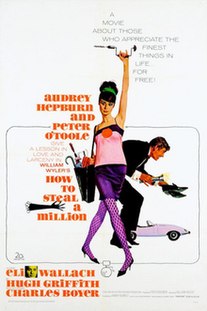
How to Steal a Million is a 1966 American heist comedy film directed by William Wyler and starring Audrey Hepburn, Peter O'Toole, Eli Wallach, Hugh Griffith and Charles Boyer. The film is set and was filmed in France, though the characters speak entirely in English. Hepburn's clothes were designed by Givenchy.

The Aphrodite of Knidos was an Ancient Greek sculpture of the goddess Aphrodite created by Praxiteles of Athens around the 4th century BC. It is one of the first life-sized representations of the nude female form in Greek history, displaying an alternative idea to male heroic nudity. Praxiteles' Aphrodite is shown nude, reaching for a bath towel while covering her pubis, which, in turn leaves her breasts exposed. Up until this point, Greek sculpture had been dominated by male nude figures. The original Greek sculpture is no longer in existence; however, many Roman copies survive of this influential work of art. Variants of the Venus Pudica are the Venus de' Medici and the Capitoline Venus.
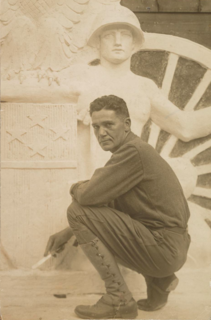
Robert Ingersoll Aitken was an American sculptor. Perhaps his most famous work is the West Pediment of the United States Supreme Court building.

The Venus de' Medici or Medici Venus is a Hellenistic marble sculpture depicting the Greek goddess of love Aphrodite. It is a 1st-century BC marble copy, perhaps made in Athens, of a bronze original Greek sculpture, following the type of the Aphrodite of Knidos, which would have been made by a sculptor in the immediate Praxitelean tradition, perhaps at the end of the century. It has become one of the navigation points by which the progress of the Western classical tradition is traced, the references to it outline the changes of taste and the process of classical scholarship. It is housed in the Uffizi Gallery, Florence, Italy.
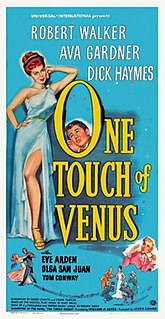
One Touch of Venus is a 1948 American black-and-white romantic musical comedy film directed by William A. Seiter starring Robert Walker, Ava Gardner and Dick Haymes. released by Universal-International, and based on the Broadway musical of the same name, book written by S. J. Perelman and Ogden Nash, with music composed by Kurt Weill. However, the film omits most of Weill's music. The actors did their own singing, except for Ava Gardner (Venus) whose singing was dubbed by Eileen Wilson. The plot is from an original story by Thomas Anstey Guthrie.

The Esquiline Venus, depicting the goddess Venus, is a smaller-than-life-size Roman nude marble sculpture of a female in sandals and a diadem headdress. It is widely viewed as a 1st-century AD Roman copy of a Greek original from the 1st century BC. It is also a possible depiction of the Ptolemaic ruler Cleopatra VII.
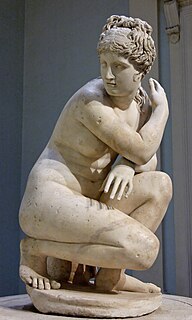
The Crouching Venus is a Hellenistic model of Venus surprised at her bath. Venus crouches with her right knee close to the ground, turns her head to the right and, in most versions, reaches her right arm over to her left shoulder to cover her breasts. To judge by the number of copies that have been excavated on Roman sites in Italy and France, this variant on Venus seems to have been popular.
La Vénus d'Ille is a short story by Prosper Mérimée. It was written in 1835 and published in 1837. It tells the story of a statue of Venus that comes to life and kills the son of its owner, whom it believes to be its husband.
"Neck" is a short story by Roald Dahl. It first appeared in his 1953 collection Someone Like You, which consists of 18 short stories.

Nanchan Temple is a Buddhist temple located near the town of Doucun on Wutaishan, Shanxi Province, China. Nanchan Temple was built in 782 during China's Tang dynasty, and its Great Buddha Hall is currently China's oldest preserved timber building extant, as wooden buildings are often prone to fire and various destructions. Not only is Nanchan Temple an important architectural site, but it also contains an original set of artistically-important Tang sculptures dating from the period of its construction. Seventeen sculptures share the hall's interior space with a small stone pagoda.

Twisted Metal is a vehicle combat video game developed by Eat Sleep Play and published by Sony Computer Entertainment for the PlayStation 3. It is a reboot of the Twisted Metal franchise. The game was originally planned to be released in October 2011 but was delayed to early 2012.
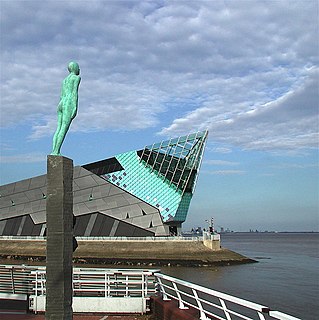
Steinunn Þórarinsdóttir is an Icelandic sculptor. Her work uses androgynous human figures such as those in her most notable exhibits Borders and Horizons.

John Lopez is an American sculptor known for his life-size hybrid metal sculptures made out of discarded farm equipment and bronze. He is equally known for his 12 life-size presidential monuments made for The City of presidents in Rapid City, South Dakota. Some of the presidents include John F. Kennedy and John Jr., Grant, Carter, Harrison, Coolidge, T. Roosevelt, and Garfield. He lives in South Dakota.















